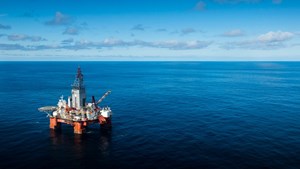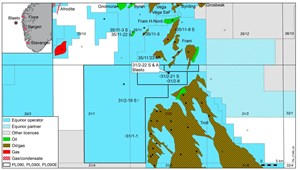Equinor and partners tally 2021’s largest Norwegian oil strike thus far
OSLO - Equinor and partners Vår Energi, Idemitsu Petroleum and Neptune Energy have made the biggest discovery so far this year on the
Norwegian continental shelf (NCS). Preliminary estimates place the size of the discovery between 12 and 19 million standard cubic meters of recoverable oil equivalent, corresponding to 75-120 million barrels of recoverable oil equivalent.
“The discovery revitalizes one of the most mature areas on the NCS. With discoveries in four of four prospects in the Fram area during the past 18 months, we have proven volumes that in total will create considerable value for society,” says Nick Ashton, Equinor’s senior vice president for exploration in Norway.
Exploration wells 31/2-22 S and 31/2-22 A in the Blasto prospect of production licenses 090, 090 I and 090 E were drilled about 3 kilometers southwest of the Fram field, 11 kilometers northwest of the Troll field and 120 kilometers northwest of Bergen.
Based on the quality of the resources and the proximity to existing infrastructure the discoveries can be developed and produced in line with Equinor’s climate goals. The company’s ambition is to reduce greenhouse gas emissions from operated fields and onshore plants in Norway by 40% by 2030, compared to 2018.
“Equinor is already an industry leader in low-carbon production. The discoveries in the Fram area will help us reach our goal of a further 40% reduction by 2030 while maintaining the current production level,” says Ashton.
Exploration well 31/2-22 S struck a total oil column of around 30 meters in the upper part of the Sognefjord formation and an oil column of around 50 meters in the lower part of the Sognefjord formation. The oil-water contacts were proven at 1860 and 1960 meters respectively.
Exploration well 31/2-22 A struck high-quality sandstone in the Sognefjord formation, but the reservoir is filled with water and the well is classified as dry.
Regarding the discovery to be commercially viable, the licensees will consider tying it to other discoveries and existing infrastructure in the area.
The wells were not formation tested, but extensive data acquisition and sampling have been carried out.
These are the first and second exploration wells in production license 090 I. The license was awarded in the 2017 awards in predefined areas (APA 2017) licensing round.
Well 31/2-22 S was drilled to a vertical depth of 2282 meters below sea level and a measured depth of 2379 meters below sea level. Well 31/2-22 A was drilled to a vertical depth of 2035 meters below sea level and a measured depth of 2207 meters below sea level.
Water depth in the area is 349 meters. The wells have been permanently plugged and abandoned.
The wells were drilled by the West Hercules drilling rig, which is proceeding to drill exploration 34/6-5 S in production license 554 in the northern North Sea sector.




